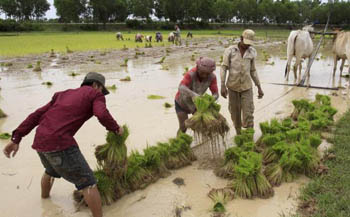|
Japan’s Damaged Rice Culture

Fukushima Nuclear Plant
EMF Computer Protection
Magnetic Field Detector
30 JANUARY 2012
The March 11, 2011
earthquake and nuclear disaster in Fukushima, Japan have
wrought havoc on the long-term prospects for the country's
storied rice industry. let alone doing short-term damage,
according to a report by the Philippines-based International
Rice Research Institute.
The Great East Japan
Earthquake, as it is known, is believed to have been the
most powerful ever to have hit Japan, triggering a
devastating tsunami that generated 40-meter waves, washing
deep inland and causing meltdowns at three reactors at the
Fukushima Nuclear Power Complex. Some 15,844 people were
confirmed dead and 3,394 people have been listed as missing.
Although the disaster
spurred evacuation of farmland in a 30-km radius around
the nuclear plant, consumer confidence in domestic rice has
fallen in a much larger area and cut into a system in which
the country has heretofore been able to maintain the
permanent sovereignty of its international agricultural
trade policies and agreements, with high tariffs keeping
Japanese farmers self-sustaining, according to the report.
United States
trade representatives in particular have fought tenaciously
to open Japanese agricultural markets to western producers,
to little avail, claiming that Californian Japonica rice is
actually tastier in addition to being cheaper. However, the
Japanese government has blocked nearly all rice imports from
countries like Thailand and Vietnam, now among the world's
biggest producers, with the Japanese government paying
farmers nearly four times the market value of their rice,
then selling it into the food distribution system at a
substantial loss. The system costs Japanese taxpayers nearly
US$2 billion a year.
While urbanization, the
drift of young people to the cities and other factors have
caused the rice sector to shrink, rice-growing remains a
revered cultural experience, with consumers and producers
saying Japanese rice is special and different from any other
species. Demographics play a grim role, however. According
to one survey, more than half of all of Japan's rice farmers
are over 65 years old. Nonetheless, families take
pilgrimages back to the countryside in the autumn to
participate in the rice harvest, which bears the hallmarks
of a cultural event rather than an agricultural process.
Although self-sufficiency been declining steadily since
World War II, "the rice industry (except for the rice
crisis) has remained at 100 percent," according to the
report.
That may no longer be true.
The report quotes Jessica
Harvey, a member of the Fukushima prefectural government
office, as saying that the prefecture was already in
financial difficulty before the 3.11 disaster and was in no
shape to offer assistance to any farmers, rice farmers
included. The sale of agricultural products, including rice
and sake - rice wine - had been a significant source of
financial income for the prefecture until now.
"With the devastation of
consumer trust in the products, the local rice industry has
been virtually destroyed," the report noted. The disaster
affected three kinds of farmers: those in the 30-km no-entry
zone, those who were dislocated because of the earthquake
itself, and those far-removed from the situation but
affected by concerns over radiation. on the part of Japan's
normally risk-averse consumers.
Production remained largely
ample. The region's rice stockpile, which previously had
been maintained at 1.84 million metric tons, rose to 2. 1
million tons because consumers wouldn't buy it, according to
the Ministry of Agriculture, Forestry and Fisheries.
Actual damage inflicted on
Japan’s rice industry as a whole, according to a
representative of the National Federation of Agricultural
Cooperative Associations identified only as a Mr Fuji, was a
miniscule 1 percent. Despite the massive earthquake, the
tsunami, and damage from radiation from the Fukushima
reactors, only 100,000 metric tons of rice were lost in all
of the affected prefectures. Of the 23,000 hectares of
agricultural land affected, 20,000 hectares were rice
production areas.
The report quotes the
cooperative association's Fuji as saying the most immediate
effort by the rice industry, in cooperation with the
governments of various levels, is the removal of salt from
brine-damaged rice paddies affected by the tsunami. The
Ministry of Agriculture, Forestry and Fisheries has
projected that the cleanup of agricultural land,
reconstruction of paddy dikes, removal of debris, rubble and
brine will take until 2014. Radiation from the destroyed
Fukushima nuclear generating plant, however, is another
question. Removing topsoil is a problem that the government
has not yet addressed. While some farmers have returned to
their properties, they do not have the funds to remove the
contaminated soil and so far have not received any financial
support from the government to be able to put in crops for
2012.
The report quotes Fuji as
saying that "concerns about the future capacity for a steady
rice supply were paled by the greater concern related to
consumer confidence in future Tohoku rice products despite
the fact that beyond the 30-km no-entry zone, successful
rice growth because of effective brine removal in tsunami
areas (spring 2011) also points to a productive 2012."
Fukushima Governor Yuhei
Sato said in a statement dated Oct. 12 that " “The
agricultural products provided by Fukushima Prefecture are
safe and fresh." The statement was followed by a long list
of categorized cereal grains including rice and vegetable
products produced in Fukushima that have passed tests for
consumption and shipment, yet with numerous exceptions
listed below each category. But consumers remain wary.
http://www.emfnews.org/store
|
